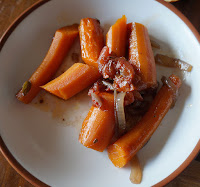 |
| Pot-roasted beef chuck. |
I have to confess that last week when I was making shredded beef for Venezuelan empanadas, I did not follow Juana’s recipe for carne mechada, which is essentially “boiled beef.” Instead I prepared beef chuck pot-roasted with wine to serve for a holiday dinner. We enjoyed the tender beef, rich gravy, roasted carrots and mashed potatoes one day. The leftovers were perfect for shredding and mixing with spicy sofrito for filling empanadas (or tacos) on another day.
“Carne mechada” actually means “larded meat.” Larding is a technique of threading strips of fat, sometimes with garlic and herbs, through a piece of meat to keep it juicy during slow cooking. Chefs use a larding needle; home cooks just cut slits in the meat and insert the seasoning with the tip of a knife.
Cutting corners, I simply mixed the garlic, spices and herbs and used them as a rub, spreading the mixture over the meat and into the crevices. Olive oil replaced larding fat.
I am still experimenting with Spanish beef cuts for pot roast. I intended to buy flank steak, which is the designated cut for making the shredded beef for empanadas. Flank may be labelled “vacío” or “falda” (which actually means the skirt, a different cut). But finding a nice hunk of aguja, which is chuck steak, I opted for that instead. I still haven’t found an equivalent to brisket.
 |
| Let meat rest before slicing. |
Pot Roast with Herbs
Carne Mechada con Hierbas
Vegetables can be added to the meat during the second hour of roasting. Carrots, parsnips, small onions, squash wedges, potatoes are all good. Personally, I like mashed potatoes alongside pot roast, the better to soak up the delicious onion gravy.
 |
| Roast vegetables with the beef. |
Serves 6.
2 pounds chuck, skirt, flank or brisket
1 teaspoon salt
Freshly ground black pepper
½ teaspoon cumin
1 teaspoon oregano
½ teaspoon thyme
1 teaspoon smoked pimentón (paprika)
1 bay leaf, crumbled
3 cloves garlic, slivered
2 tablespoons olive oil
1 large onion, sliced
1 cup red wine
½ cup pureed fresh or canned tomatoes
½ beef bouillon cube (optional)
Carrots or other vegetables
Flour or cornstarch to thicken gravy (optional)
The piece of chuck can be left whole or divided into 3 or 4 chunks. In a small bowl combine the salt, pepper, cumin, oregano, thyme, pimentón and bay leaf. Rub this mixture on all sides of the meat, particularly into the deep crevices between muscles. Insert slivers of garlic where possible. Drizzle over the oil. Let the meat rest at room temperature for 40 minutes (or refrigerated up to 24 hours).
Preheat oven to 400ºF.
Lightly oil a roasting pan or cast iron skillet. Layer the onions on the bottom of the pan and place the meat on top. Roast the meat 20 minutes.
Lower oven temperature to 325ºF. Add wine and tomatoes to the pan. Crumble the bouillon cube, if using, and scatter it around and over the meat. Place lid on pan or cover the meat with a sheet of aluminum foil. Return the pan to the oven for 60 minutes.
Baste the meat with the liquid in the pan. Add carrots or other vegetables to the pan. Cover and return to the oven until the meat is fork tender, about 60 minutes.
 |
| Pan juices for gravy. |
 |
| Carrots on the side. |
Place the meat on a cutting board and allow it to stand 10 minutes before slicing.
The pan juices with onions can be reheated and served alongside the meat or the onions strained out and the liquid thickened with flour or cornstarch. If not serving immediately, cool the meat in the cooking liquid and refrigerate it.
More recipes for braised or stewed beef:

That looks delicious! I was buying very good brisket in Calella - I explained to the butcher what I wanted and he took me out back to examine half a cow. After that I could call him and he'd drop one off (to be smoked) the next day.
ReplyDelete<Mad Dog: Wow. Do you remember what the cut is called in Spanish? My local butchers are no longer butchers, though their fathers were.
DeleteI had to think about it for 5 minutes - pecho de res.
DeleteMad Dog: Will try pecho next time I go to big store. I also found "aleta" and "contra-aleta" as possible.
DeleteAleta is behind the brisket - it's bavette, but contra-aleta may be the opposite side, which could be the back of the brisket. You could take a beef cuts chart with you to show them exactly which piece you'd like. You can find images with Google.
DeleteMad Dog: Thanks for this. I'll let you know.
Delete